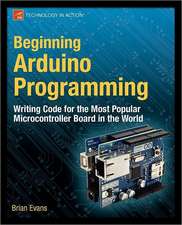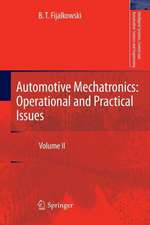Digital Photoelasticity: Advanced Techniques and Applications
Autor K. Rameshen Limba Engleză Paperback – 20 noi 2013
Preț: 641.50 lei
Preț vechi: 754.70 lei
-15% Nou
Puncte Express: 962
Preț estimativ în valută:
122.77€ • 127.70$ • 101.35£
122.77€ • 127.70$ • 101.35£
Carte tipărită la comandă
Livrare economică 14-28 aprilie
Preluare comenzi: 021 569.72.76
Specificații
ISBN-13: 9783642640995
ISBN-10: 3642640990
Pagini: 432
Ilustrații: XX, 410 p. 103 illus.
Dimensiuni: 155 x 235 x 23 mm
Greutate: 0.6 kg
Ediția:Softcover reprint of the original 1st ed. 2000
Editura: Springer Berlin, Heidelberg
Colecția Springer
Locul publicării:Berlin, Heidelberg, Germany
ISBN-10: 3642640990
Pagini: 432
Ilustrații: XX, 410 p. 103 illus.
Dimensiuni: 155 x 235 x 23 mm
Greutate: 0.6 kg
Ediția:Softcover reprint of the original 1st ed. 2000
Editura: Springer Berlin, Heidelberg
Colecția Springer
Locul publicării:Berlin, Heidelberg, Germany
Public țintă
ResearchCuprins
1 Transmission Photoelasticity.- 2 Reflection Photoelasticity.- 3 Digital Image Processing.- 4 Fringe Multiplication, Fringe Thinning and Fringe Clustering.- 5 Phase Shifting, Polarization Stepping and Fourier Transform Methods.- 6 Phase Unwrapping and Optically Enhanced Tiling in Digital Photoelasticity.- 7 Colour Image Processing Techniques.- 8 Evaluation of Contact Stress Parameters and Fracture Parameters.- 9 Stress Separation Techniques.- 10 Fusion of Digital Photoelasticity, Rapid Prototyping and Rapid Tooling Technologies.- 11 Recent Developments and Future Trends.
Recenzii
Excerpts from the Reviews of the book on Digital Photoelasticity(Pattern I)
The author has produced a first class text book that should find widespread use among students, researchers, and design engineers in many branches of engineering…..
Applied Mechanics Reviews 55(4) B69-B71 JUL 2002
The book is accompanied by a CD-ROM of the C source code of the programs referred to in the text along with some photoelasticity simulations and some hardware-specific code. The text is supported by ample end-of-chapter tutorial questions…..
Strain 38 85-86 2002
Bible of digital photoelasticity., 17 February, 2001
Not only beginners and students but also researchers, engineers and inspectors should read this book as a bible of photoelasticity.
http://www.amazon.co.uk/exec/obidos/ASIN/3540667954/qid%3D1050727743/202-1368056-3855028
….This is the first monograph in its field and forms a useful contribution…
Meas. Sci. Technol. 11 (December 2000) 1826-1827
The author has produced a first class text book that should find widespread use among students, researchers, and design engineers in many branches of engineering…..
Applied Mechanics Reviews 55(4) B69-B71 JUL 2002
The book is accompanied by a CD-ROM of the C source code of the programs referred to in the text along with some photoelasticity simulations and some hardware-specific code. The text is supported by ample end-of-chapter tutorial questions…..
Strain 38 85-86 2002
Bible of digital photoelasticity., 17 February, 2001
Not only beginners and students but also researchers, engineers and inspectors should read this book as a bible of photoelasticity.
http://www.amazon.co.uk/exec/obidos/ASIN/3540667954/qid%3D1050727743/202-1368056-3855028
….This is the first monograph in its field and forms a useful contribution…
Meas. Sci. Technol. 11 (December 2000) 1826-1827
Textul de pe ultima copertă
The principal objectives of the book are to provide an introduction to basic concepts and methodologies for digital photoelasticity and to develop a foundation on which the future researcher and student can develop his on ideas and promote research in formulation of problems in digital photoelasticity and application of these techniques to industries. Particular care has been taken to give a clear, straightforward, and simple presentation of various topics. In one volume it provides data acquisition by DIP techniques, data analysis by statistical techniques, data presentation by computer graphics and the use of Rapid Prototyping technologies to enhance the speed of the entire process. The book not only presents the various techniques but also provides time-tested software codes for important techniques. Exercises designed to support and extend the treatment have been placed at the end of each chapter.
Caracteristici
The book describes the combination of the stress-analysis technique of photoelasticity with modern computer methods like digital image processing He gives an outlook how this automated photoelasticity can be used in innovative industrial methods like rapid prototyping and rapid tooling The CD-ROM contains computer programs with algorithms and simulations, and color images Includes supplementary material: sn.pub/extras













